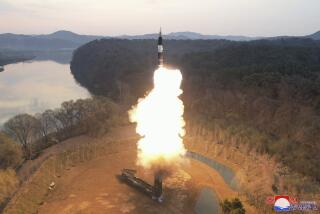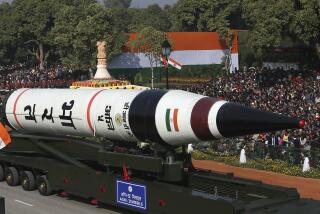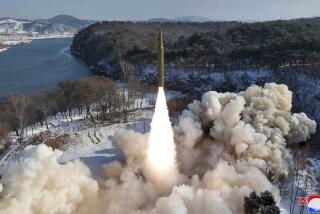Could a North Korean missile hit Washington? Latest ICBM launch suggests it’s possible

The Pentagon said the device appeared to be an intercontinental ballistic missile that traveled about 600 miles before splashing into the sea. (Nov 28 , 2017)
North Korea on Wednesday test-launched a ballistic missile for the first time since September, its latest provocation that could further exacerbate tensions with the international community.
The launch occurred at 3:17 a.m. from Pyongsong, in South Pyongan province, and the missile flew into the East Sea, according to a statement from the South Korean joint chiefs of staff.
South Korean officials said the missile appeared to fly on a sharp trajectory, soaring about 2,800 miles into space before descending. In theory, that means it could fly on a flatter path for about 8,000 miles — far enough to put Washington at risk, according to David Wright, co-director of the Global Security Program at the Union of Concerned Scientists. Such a flight, however, would depend on the weight of its payload.
The Pentagon said the device appeared to be an intercontinental ballistic missile that traveled about 600 miles before splashing into the sea. If so, it would have been the third ICBM launched by North Korea, all of them this year.
“We are working with our interagency partners on a more detailed assessment of the launch,” said Pentagon spokesman Col. Robert Manning. “Our commitment to the defense of our allies, including the Republic of Korea and Japan, in the face of these threats, remains ironclad. We remain prepared to defend ourselves and our allies from any attack or provocation.”
President Trump, addressing reporters at the White House, seemed to brush off the significance of the launch. “We’ll take care of it,” he said. “It is a situation that we will handle.”
The launch is yet another signal from the North’s totalitarian government, which has few allies or trading partners around the world, that it intends to continue ignoring United Nations Security Council resolutions outlawing its pursuit of a long-range ballistic missile and a nuclear weapons program.
It also comes a little more than a week after Trump redesignated North Korea as a state sponsor of terrorism, and two weeks after a North Korean soldier defected to South Korea in a high-profile escape at a sensitive outpost along the 160-mile border between the two countries.
The North already is widely considered to be a nuclear state, and the focus of concern lately has been on its ability to deliver the weapons via a miniaturized warhead and powerful missiles. The country apparently has made progress on both fronts, according to its recent launches and statements regarding warheads.
Wednesday’s launch was the 70th missile test — some of which have included multiple devices — since North Korean leader Kim Jong Un took power after his father’s death in December 2011. The country has conducted four underground nuclear tests during that time: one in 2013, two in 2016 and one in September. Two previous underground tests were conducted by his father, the late Kim Jong Il: One in 2006 and the other in 2009.
Their explosive yield has increased each time.
Based on both intelligence and history, North Korea watchers had been expecting another test, with some suggesting the relative quiet in recent months had more to do with the season than strategy.
South Korea’s unification minister, Cho Myoung-gyon, said Tuesday afternoon that the government had received reports about suspicious “noteworthy movement” suggesting a launch could be imminent.
South Korean President Moon Jae-in issued a statement saying his government “will never let North Korea’s provocations stand,” and promising to “strengthen our ability to protect the Republic of Korea from North Korea’s nuclear and missile threats.”
Just after the launch, the South Korean military performed its own missile exercise on the East Sea, also known as the Sea of Japan, involving its army, navy and air forces. The South Korean joint chiefs of staff said its forces launched missiles that traveled roughly the same distance as would be required to strike the North Korean missile launch site.
“This training shows our military watches the military trends of North Korea 24 hours a day and shows the ability and willingness to precisely strike the provocation origin and core facilities at any time from ground, sea and air,” the military said in a news release.
Cho, the unification minister, said South Korea believes the North could perfect the ability to deploy nuclear weapons capable of striking the U.S. mainland within a few years, if not sooner.
“We are not ruling out any possibilities with regard to North Korea. This year, North Korea has improved its nuclear capability as well as its missile technology, and we expect they are targeting to complete their nuclear and missile technology very soon,” he said, according to an English translation provided by the ministry. “North Korea has a proven track record of moving faster than anyone’s expectations, so we will not be surprised if they make a declaration that they are a nuclear power in 2018.”
In Washington, Secretary of State Rex Tillerson issued a statement saying North Korea’s “relentless pursuit of nuclear weapons and the means to deliver them must be reversed.” He said the United States had called a meeting of relevant U.N. members, including South Korea and Japan, “to discuss how the global community can counter North Korea’s threat to international peace.”
As on Wednesday, many of the launches in recent years have involved short- and medium-range missiles launched into the East Sea between North Korea and Japan. The launches violate U.N. resolutions intended to curb Pyongyang’s nuclear ambitions. Two recent launches, however, flew over Japanese territory into the northern Pacific Ocean, raising further alarm.
Kim Jong Il also oversaw missile tests — roughly two dozen — before his death.
In a televised speech this year, the younger Kim said the country had a national goal of building and deploying powerful missiles — and of arming them with nuclear warheads — that could reach the U.S. mainland.
Tensions had cooled in recent months because the North had refrained from further tests. This was despite Trump taunting Kim with the nickname “Little Rocket Man” and threatening — in his first speech to a United Nations General Assembly — to “totally destroy” North Korea if threats continued.
Kim responded with a statement of his own, a rare first-person address for a North Korean leader, questioning Trump’s mental ability and competence: “I will surely and definitely tame the mentally deranged U.S. dotard with fire,” he said.
Stiles is a special correspondent. Times staff writers Noah Bierman and Tracy Wilkinson in Washington contributed to this report.
UPDATES:
4:25 p.m.: This article was updated with South Korea also conducting a missile test and a statement from Moon.
2:15 p.m.: This article was updated with comment about Washington being potentially at risk.
2 p.m.: This article was updated with Tillerson comments.
1:30 p.m.: This article was updated with statements from President Trump, the Pentagon and South Korea’s unification minister.
11:40 a.m.: This article was updated throughout with staff reporting, official comments and background.
11:05 a.m.: This article was updated with background preceding the launch.
This article was originally published at 10:35 a.m.
More to Read
Start your day right
Sign up for Essential California for news, features and recommendations from the L.A. Times and beyond in your inbox six days a week.
You may occasionally receive promotional content from the Los Angeles Times.







